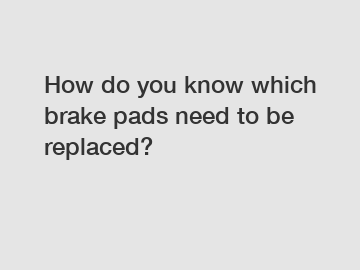How do you know which brake pads need to be replaced?
How do you know which brake pads need to be replaced?
Brake pads play a vital role in ensuring our safety on the roads. Over time, they wear out and need to be replaced to maintain optimal braking performance. But how do you know when it's time to change your brake pads? In this article, we will discuss the signs that indicate when your brake pads need replacement.
1. Squeaking or Squealing Noise:

One of the first indicators that your brake pads are worn out or nearing the end of their service life is a squeaking or squealing noise. This noise is often caused by a small metal shim called a "wear indicator" that comes in contact with the brake rotor. When the brake pad becomes thin, the wear indicator starts to touch the rotor, creating the high-pitched noise. If you notice this sound when applying the brakes, it's a clear sign that your brake pads are due for a replacement.
2. Reduced Brake Responsiveness:
Another sign that your brake pads need to be replaced is a decrease in brake responsiveness. If you find that you need to apply more pressure on the brake pedal to bring your vehicle to a stop, it could indicate worn-out brake pads. As the brake pad material wears down, the friction between the pad and the rotor decreases, resulting in diminished stopping power. If your brakes feel less responsive than before, it's time to have your pads inspected and replaced, if necessary.
3. Vibration or Pulsation:
A vibrating or pulsating sensation when you apply the brakes can be an indication of unevenly worn brake pads. This uneven wear can cause the brake pads and rotors to develop an uneven surface, leading to vibrations when braking. If you experience this sensation, it's crucial to have your brake pads checked as soon as possible. Ignoring this issue can result in further damage to the braking system and potential safety hazards.
4. Visible Inspection:
In some cases, a visual inspection can help determine if brake pads need to be replaced. Most brake pads have a "minimum thickness" groove or indicator, visible from the side. This groove indicates the minimum thickness the pad should have for safe operation. If the pad material is worn down to or past this indicator, it's a clear indication that replacement is necessary. Additionally, you can remove the wheels and inspect the brake pads directly. If the material is significantly worn, it's time for new brake pads.
Conclusion:
Maintaining a well-functioning brake system is crucial for your safety and the safety of others on the road. Knowing the signs that indicate when your brake pads need to be replaced is essential to avoid potential accidents and ensure proper vehicle maintenance. Keep an ear out for any squeaking or squealing noises while braking, as well as reduced brake responsiveness and vibrations. Additionally, conducting a visual inspection of the brake pads can provide a clear indication of their condition. By proactively monitoring these signs, you can replace your brake pads promptly and enjoy a safe driving experience.
If you want to learn more, please visit our website MGZS Auto Parts, High Quality Saic MG Car Headlamp, Supply Original Clutch Kit MG GS.

Comments
0